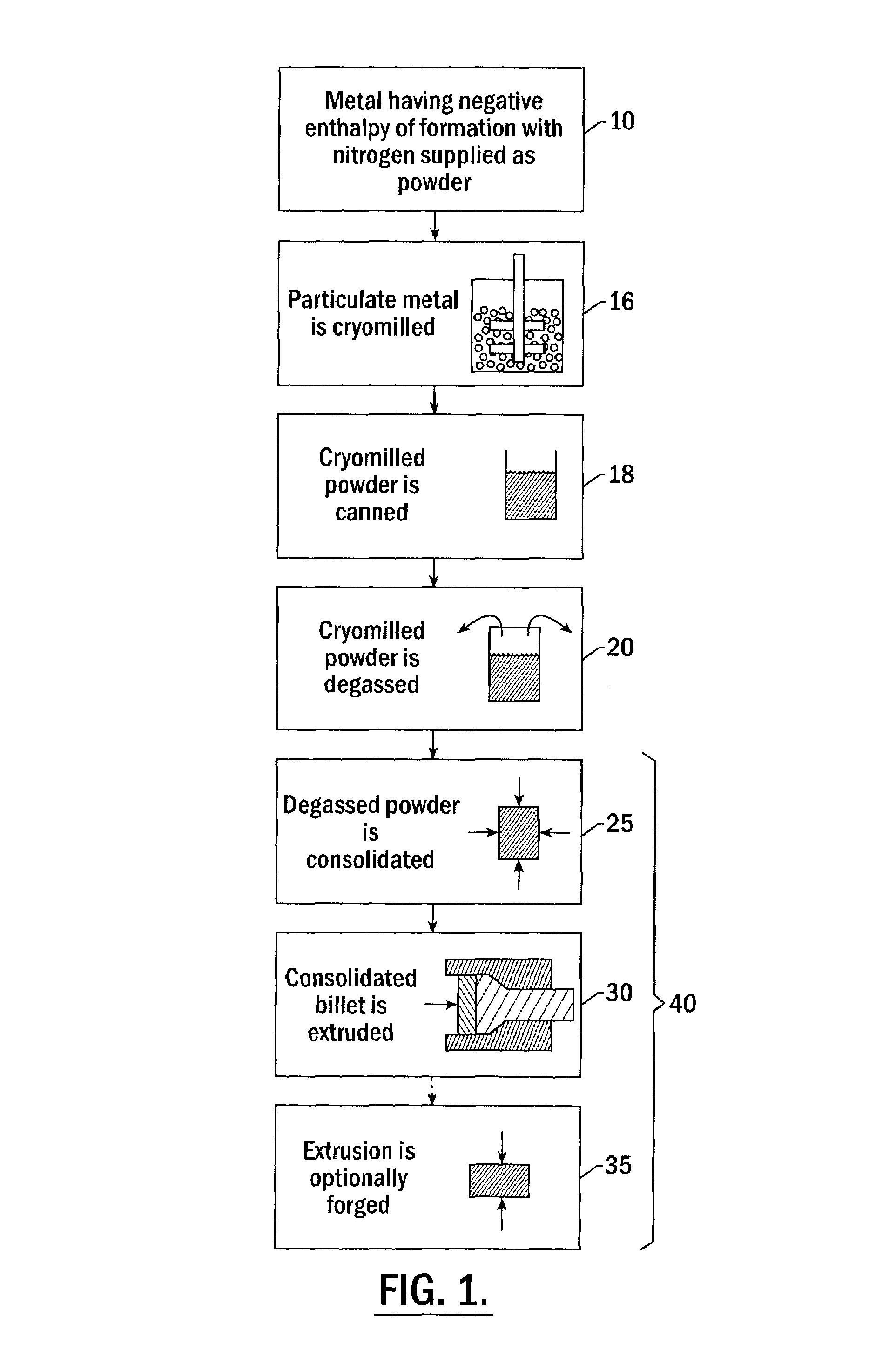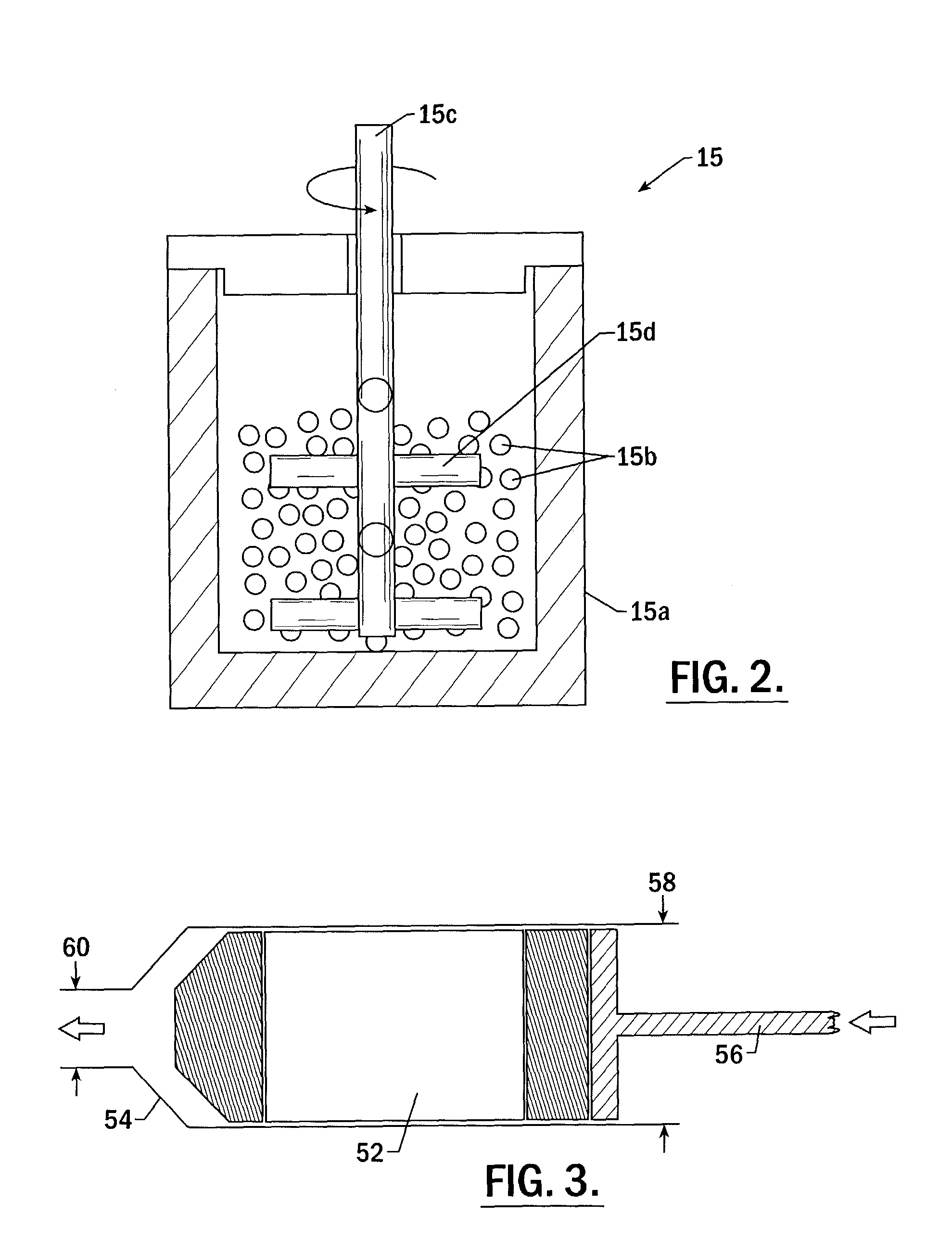Method for preparing nanostructured metal alloys having increased nitride content
a technology of nanostructured metal alloys and nitride, which is applied in the direction of solid state diffusion coating, grain treatment, transportation and packaging, etc., can solve the problems of reducing the ductility of alloys primarily aluminum, increasing the amount of nitrogen added, and reducing the ductility, so as to reduce grain growth and high strength , the effect of high strength metal articles
- Summary
- Abstract
- Description
- Claims
- Application Information
AI Technical Summary
Benefits of technology
Problems solved by technology
Method used
Image
Examples
example 1
Production and Testing of Aluminum / Magnesium Alloy with 0.3%
[0049]Aluminum alloy powders of composition 6.7 wt % Mg+Al (balance) were cryomilled, canned, degassed, consolidated, and extruded into a 3″ diameter bar. Cryomilling was carried out as follows. The attritor was filled with 640 kg grams of 0.25 inch diameter steel balls. Liquid nitrogen was flowed into the attritor. Flow was maintained for at least about one hour to cool the balls and attritor until the rate of boil off was sufficiently low to allow the balls to become completely submerged in the liquid nitrogen. A transfer hopper was loaded with 17445 grams of aluminum powder, 2555 grams of 50 wt % aluminum 50 wt % magnesium powder, and 40 grams of stearic acid. Loading of the hopper was carried out in a glove box under dry nitrogen purge. These components were transferred from the hopper into the attritor by draining from the hopper into a tube inserted through the lid of the attritor vessel. The attritor arms were then r...
example 2
Production and Testing of Aluminum / Magnesium Alloy with 0.45%
[0054]Aluminum alloy powders of composition 6.7 wt % Mg+Al (balance) were cryomilled, canned, degassed, consolidated, and extruded into a 3″ diameter bar as described in Example 1 above, except that the powders were cryomilled at an attritor speed of 100 RPM for a time sufficient to increase the nitride content of the powder by 0.45 wt %.
[0055]Average grain size of the resulting extrusion was determined by Field Emission SEM (Scanning Electronic Microscope) to be 200 nm.
[0056]Comparison of the alloy extrusions of Examples 1 and 2 indicate that increased nitride content introduced by cryomilling of a metallic alloy corresponds to decreased grain growth during thermo-mechanical processing. The alloy with 0.3 wt % nitrogen as intrinsically formed nitrides resulted in an alloy, after thermo-mechanical processing (HIPping), with a grain size of 400 nm. The alloy with 0.45 wt % nitrogen of intrinsically formed nitrides resulted ...
example 3
Measured Correlation Between Ultimate Tensile Strength and Nitrogen Content
[0057]Metal samples were prepared generally in accordance with the method outlined in Example 1, resulting in the compositions specified in Table 2. The data and graph was generated from readings taken at room temperature, about 20° C. Room temperature measurements tended to give a more accurate presentation of ductility, so they were used instead of readings at cryogenic temperatures.
[0058]
TABLE 2Comparison of aluminum alloy samples having differing nitrogen contentvs. Ultimate Tensile Strength and ElongationSample ID #O2N2CH2UTS rtElongation rt00.560.561691541021.510.380.5414204993.64.720.410.4312214190.64.930.510.65153269104140.450.82174969.5101.21.350.350.7515654399.41.860.410.72159052.599.31.770.240.46156040.292.35.480.250.52144332.891.56.490.240.56162050.492.35100.240.59167040.996.25.7110.250.58168343.394.45.7120.230.39168740.488.45.7130.180.29197026.1874.5140.230.31182827.889.54.3150.230.32210131.7866....
PUM
| Property | Measurement | Unit |
|---|---|---|
| Grain size | aaaaa | aaaaa |
| Grain size | aaaaa | aaaaa |
| Grain size | aaaaa | aaaaa |
Abstract
Description
Claims
Application Information
 Login to View More
Login to View More - R&D
- Intellectual Property
- Life Sciences
- Materials
- Tech Scout
- Unparalleled Data Quality
- Higher Quality Content
- 60% Fewer Hallucinations
Browse by: Latest US Patents, China's latest patents, Technical Efficacy Thesaurus, Application Domain, Technology Topic, Popular Technical Reports.
© 2025 PatSnap. All rights reserved.Legal|Privacy policy|Modern Slavery Act Transparency Statement|Sitemap|About US| Contact US: help@patsnap.com



